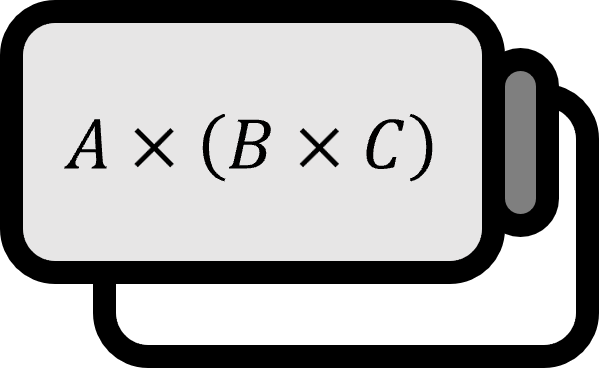Divergence of Vector Functions in Curvilinear Coordinates
Theorem
The divergence of the vector function $\mathbf{F}=\mathbf{F}(q_{1},q_{2},q_{3})=F_{1}\hat{\mathbf{q}}_{1}+F_{2}\hat{\mathbf{q}}_{2}+F_{3}\hat{\mathbf{q}}_{3}$ in curvilinear coordinates is as follows.
$$ \nabla \cdot \mathbf{F}=\frac{1}{h_{1}h_{2}h_{3}}\left[ \frac{ \partial }{ \partial q_{1} }(h_{2}h_{3}F_{1})+\frac{ \partial }{ \partial q_{2} }(h_{1}h_{3}F_{2})+\frac{ \partial }{ \partial q_{3} }(h_{1}h_{2}F_{3}) \right] $$
$h_{i}$ is the scale factor.
Formulas
Cartesian coordinates:
$$ h_{1}=h_{2}=h_{3}=1 $$
$$ \begin{align*} \nabla \cdot \mathbf{F} =\frac{\partial F_{x}}{\partial x}+\frac{\partial F_{y}}{\partial y}+\frac{\partial F_{z}}{\partial z} \end{align*} $$
Cylindrical coordinates:
$$ h_{1}=1,\quad h_{2}=\rho,\quad h_{3}=1 $$
$$ \begin{align*} \nabla \cdot \mathbf{F} &= \frac{1}{\rho} \left( \frac{\partial (\rho F_{\rho})}{\partial \rho} + \frac{\partial (F_{\phi})}{\partial \phi} + \frac{\partial (\rho F_{z})}{\partial z} \right) \\ &= \frac{1}{\rho} \frac{\partial (\rho F_{\rho})}{\partial \rho} + \frac{1}{\rho}\frac{\partial F_{\phi}}{\partial \phi} + \frac{\partial F_{z}}{\partial z} \end{align*} $$
- Spherical coordinates:
$$ h_{1}=1,\quad h_{2}=r\quad, h_{3}=r\sin\theta $$
$$ \begin{align*} \nabla \cdot \mathbf{F} &= \frac{1}{r^{2}\sin\theta}\left( \frac{\partial (r^{2}\sin\theta F_{r})}{\partial r}+\frac{\partial (r\sin\theta F_{\theta})}{\partial \theta}+\frac{\partial (rF_{\phi})}{\partial \phi} \right) \\ &= \frac{1}{r^{2}}\frac{\partial (r^{2} F_{r})}{\partial r}+\frac{1}{r\sin\theta}\frac{\partial (\sin\theta F_{\theta})}{\partial \theta}+\frac{1}{r\sin\theta}\frac{\partial F_{\phi}}{\partial \phi} \end{align*} $$
Derivation
In the 3D Cartesian coordinate system, the divergence $\nabla \cdot \mathbf{F}$ of the vector function $\mathbf{F}$ told us how $\mathbf{F}$ flows. We can get the divergence in the curvilinear coordinates in the same way. Let’s first compute it only in the direction of $q_{1}$ axis. The amount passing through $d\mathbf{a}_{1}$ and $d\mathbf{a}_{2}$ can be calculated by the inner product of the two vectors. The computation is the same as in the Cartesian coordinates, so some parts are omitted.
$$ \begin{align*} \mathbf{F}(q_{1}+dq_{1},q_{2},q_{3})\cdot d\mathbf{a}_{1} &= F_{1}(q_{1}+dq_{1},q_{2},q_{3})h_{2}h_{3}dq_{2}dq_{3} \\ \mathbf{F}(q_{1},q_{2},q_{3})\cdot d\mathbf{a}_{2} &=- F_{1}(q_{1},q_{2},q_{3})h_{2}h_{3}dq_{2}dq_{3} \end{align*} $$
And the sum of these two is the influx (outflux).
$$ \begin{align*} &F_{1}(q_{1}+dq_{1},q_{2},q_{3})h_{2}h_{3}dq_{2}dq_{3}- F_{1}(q_{1},q_{2},q_{3})h_{2}h_{3}dq_{2}dq_{3} \\ =& \frac{F_{1}(q_{1}+dq_{1},q_{2},q_{3})h_{2}h_{3}- F_{1}(q_{1},q_{2},q_{3})h_{2}h_{3} }{dq_{1}}dq_{1}dq_{2}dq_{3} \\ \approx &\frac{ \partial (F_{1}h_{2}h_{3})}{ \partial q_{1}}dq_{1}dq_{2}dq_{3} \end{align*} $$
In the same way, if calculated for $q_{2}$ and $q_{3}$, it is as follows.
$$ \frac{ \partial (F_{2}h_{1}h_{3})}{ \partial q_{2}}dq_{1}dq_{2}dq_{3}\quad \text{and} \quad \frac{ \partial (F_{3}h_{1}h_{2})}{ \partial q_{3}}dq_{1}dq_{2}dq_{3} $$
Adding these gives the amount of $\mathbf{F}$ entering or leaving, and dividing it by the volume $dV=h_{1}h_{2}h_{3}dq_{1}dq_{2}dq_{3}$ gives the influx (outflux) per unit volume.
$$ \begin{align*} & \frac{ \partial (F_{1}h_{2}h_{3})}{ \partial q_{1}}dq_{1}dq_{2}dq_{3}+\frac{ \partial (F_{2}h_{1}h_{3})}{ \partial q_{2}}dq_{1}dq_{2}dq_{3}+\frac{ \partial (F_{3}h_{1}h_{2})}{ \partial q_{3}}dq_{1}dq_{2}dq_{3} \\ =&\ \left( \frac{ \partial (F_{1}h_{2}h_{3})}{ \partial q_{1}}+\frac{ \partial (F_{2}h_{1}h_{3})}{ \partial q_{2}}+\frac{ \partial (F_{3}h_{1}h_{2})}{ \partial q_{3}} \right)dq_{1}dq_{2}dq_{3} \\ \frac{1}{dV}\times \implies &\frac{1}{h_{1}h_{2}h_{3}}\left( \frac{ \partial (F_{1}h_{2}h_{3})}{ \partial q_{1}}+\frac{ \partial (F_{2}h_{1}h_{3})}{ \partial q_{2}}+\frac{ \partial (F_{3}h_{1}h_{2})}{ \partial q_{3}} \right) \end{align*} $$
■
